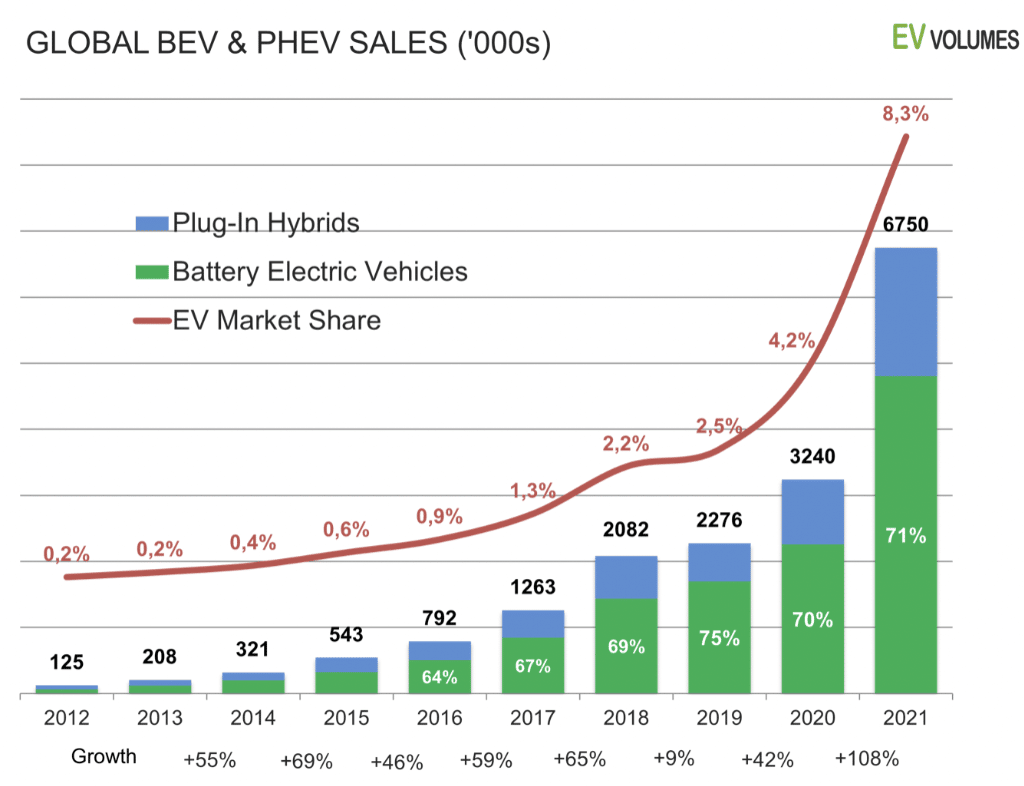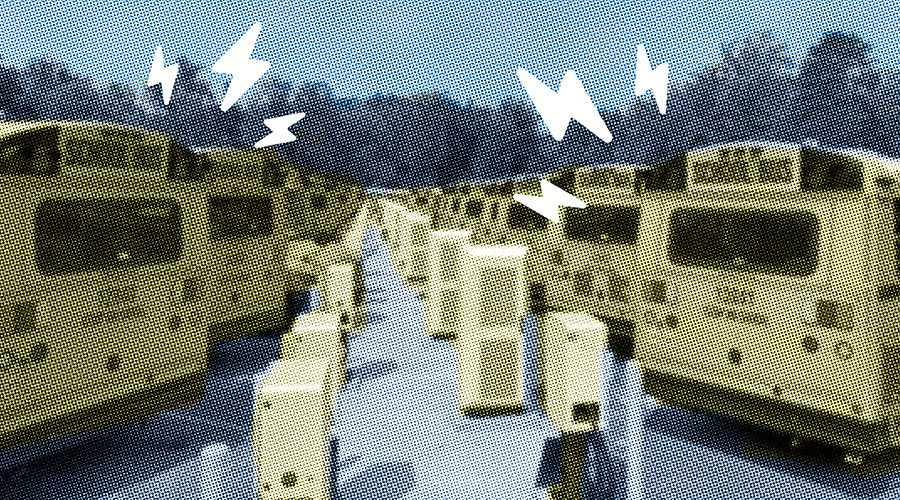When Henry Ford unveiled his history-changing Model T in 1908, there hardly was any infrastructure to support widespread transport by car. Paved roads were scarce, gas stations were few and far between, and horse-drawn carriages were the preferred way to travel.
Despite these challenges, it didn’t take long for the clearly better transportation option to go mainstream. In a little over a decade, Model T’s were everywhere, replacing the horses that had moved people for hundreds of years.
Though not a perfect comparison, the switch from the internal combustion engine to the electric one has a lot in common with the horse-to-car evolution. Many automobile prototypes preceded Henry Ford’s version. Combined with the creation of The Office of Public Roads in 1905, Ford’s unique assembly line approach unlocked the broad-based adoption earlier producers only dreamed of.
Thanks to federal and state incentives, EVs are rapidly approaching cost parity with combustion engine vehicles, and are projected to get cheaper as the cost of owning the latter rises each year depending on unpredictable global oil markets. The recently-passed Inflation Reduction Act (IRA) includes provisions to accelerate the cost reductions for Americans and the nationwide charging infrastructure to support the new models.
However, we shouldn’t declare victory yet. Passenger cars are just one way people get themselves and goods around.
Electric buses and bikes, like EVs, are popping up everywhere. But that’s the low-hanging fruit—electric planes, trains, medium and heavy duty trucks, and cargo ships will be a much harder nut to crack, and spew out a significant amount of GHGs.
So, where do we stand today with the transition to electric transportation? What are the biggest barriers, and how can you play a role in hastening the movement?
To help answer these questions, let’s widen the scope and learn from other tectonic changes in technology.
Shifts in technology happen slowly, then all at once
While no one reading this remembers the horse-to-car conversion, you may remember the sudden proliferation of smartphones at the start of the century. Looking back on it now, it seems obvious—of course computers would get smaller until they fit into our pockets.
But even experts in the field had no idea what was coming. Back in 1980, Motorola expected that “car phones” would dominate the market, and projected a little over 1 million phones would be sold in the year 2000.
The actual number? 109 million.
Widespread adoption of new tech often happens faster than people think, after a long period of low growth. The kicker is usually when the new, better product reaches a competitive price level with the legacy product and consumer demand begins dictating supply. For EVs, industry experts predicted this tipping point would be reached when a vehicle hit the market that could last 200 miles on one charge and cost less than $30k.
Well, Tesla hit that mark in 2017 with its Model 3, and EV sales have been growing exponentially since then, as shown in the chart below.

That’s a textbook exponential curve, and a promising sign for reducing GHG emissions from passenger cars. Although EVs represent less than 10% of global car sales, if this trend continues, they’ll make up the majority of new vehicle purchases by 2050.
This is great news, but there’s a catch.
Unfortunately, despite projections of EVs dominating new car sales very soon, gasoline cars are expected to hold onto their lead, even in 2050.
Even if you’re an environmental champion, changing vehicles takes some thought. Most people need to see cost competitiveness and enticing new benefits to make the switch from a current vehicle that works just fine.

Suggested remedies for this issue include more EV tax credits and government gasoline-car-buyback programs. But, with enough gas-powered cars currently in the world to stretch from Sydney to London many times over, it’ll take a while before gas cars go the way of the horse and buggy.
Armed with this historical perspective, let’s take a look at where the electric transportation transition stands today.
Range-bound
Electric cars are incredible machines. We didn’t merely come up with a way to get us around sans-combustion. We cranked the power way up in the process.
EVs have better acceleration than gas cars, mainly due to their uncomplicated engines compared to the internal combustion variety. These simplified engines also require less maintenance.
People absolutely love these things, and all signs point to mass adoption in the near term. The question is how soon that point comes.
Two key variables will affect the timeline—price and range. The comfort in knowing that you can refuel at a gas station just about anywhere in the country is important to people. As a result, “range anxiety” will persist until charging stations proliferate, ranges increase, and charge time go down.
Component shortages and other supply chain woes have kept EV prices elevated in spite of tax credits, increasing economies of scale, and other industry tailwinds. An uncertain economic future looms on the horizon, and a recession could set the market back.
As the chart above shows, gas cars will be stubborn to stamp out. For a fully electric future to become reality, gas cars probably have to phase out of the market by 2035. California recently committed to this timeline, reinforcing the world’s fifth largest economy as a leader in shaping our clean energy future.
Renewed hope for federal electrification support
Just when climate change advocates had given up hope on federal action, Joe Manchin came to the table at the last minute and emerged with a deal. The IRA may be labeled as an effort to tamp down inflation, but includes a whopping $370 billion in investments for energy security and electrification.
Labeled as “the United States’ biggest and most ambitious climate change legislation ever,” the IRA marks a renewed commitment from the U.S. to combat climate change. It’s expected to reduce U.S. GHG emissions 40% by 2030, which seemed like a pipedream just a few months ago.
Some of the highlights of the law include tax breaks for new and used EVs, language that strengthens the EPA’s regulatory authority, projected energy bill savings, and investments for new clean energy jobs. Plenty of good stuff!
This law is a game-changer, but we shouldn’t declare victory just yet. Better to think of the IRA as setting the stage for more drastic action, as public and private actors now have the financial incentive to invest in economy-wide electrification solutions.
The U.S. Postal Service made a splash this summer when it announced that half its new mail trucks would be electric. But the IRA enables it to go even further—a $3 billion allocation for more EVs and charging infrastructure sets the stage for a fully-electric mail delivery system in the near future.
Charging stations remain a thorn in the side of EV advocates, and the IRA tackles it head-on. The “Alternative Fuel Vehicle Refueling Property Credit” grants producers a 30% discount on the cost of new charging stations with cities, states, and private businesses already installing chargers.
Even the number of electric school buses, a favorite among Flip the Script readers, stands to grow. Class 6 and 7 school buses are eligible for the $1 billion in funding for new electric commercial vehicles outlined in the law.
The IRA was a historic step forward for America, but a lot of work lies ahead. So, now that the foundation is set, what are the biggest barriers still facing mass electrification?
A great start, but a long way to go
President Biden came into office promising to halve U.S. GHG emissions by 2030. While the 40% reduction estimated post-IRA is great, it falls short of that mark.
That doesn’t necessarily mean a 50% reduction is out of reach, though. Government agencies like the EPA have been empowered to pitch in. The Hill thinks the “EPA should use its expanded capacities to help the U.S. bridge that remaining 10 percent gap.”
While the EPA will look to reassert its authority with this new mandate, utilities across the country need to step up too.
Grids need to be updated to handle the increased loads caused by the EV surge. In its current iteration, the U.S. grid can’t handle massive increases in load demands. Luckily, experts are aware of what’s coming.
Pre-IRA, Biden passed a law promising $5 billion in funding for grid updates that would enable a nationwide charging network. Private and public utilities, along with EV companies, are expected to put some money on the table as well, as all have a shared interest in a well-functioning charging network.
So that’s the current state of the electric transportation transition in a nutshell. Now what can you do to support the movement?
Ways you can plug-in
Similar to the climate change fight, small actions from each of us can make a big difference over time and send the market signal that EV producers need.
Here are a few suggestions:
- Pledge to make your next car electric. Not everyone is able to run out and buy an EV tomorrow, but promising to make your next car electric when the time comes is still a huge step.
- Publicly support charging stations for EVs and electric school buses. If you live in a complex without any charging stations, see if you can rally support to put one in. You can ask your workplace to install a charging station, too.
- Talk to your local representatives about implementing a municipal electrification program. Cities like Columbus, OH have reached stunning EV adoption rates when considering infrastructure and EV purchases together.
With the tipping point for mass EV adoption right around the corner and the urgency of climate change, we have no time to waste. Let’s use the IRA as a jumping point for even more significant action to make widespread transportation electrification a reality.















